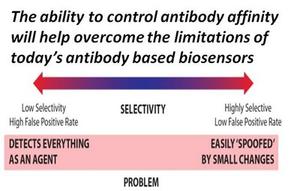BiowarfareImproving detection of, responses to biological warfare
Biological warfare agents pose more than a hypothetical threat to U.S. soldiers. Troops operate in hostile areas where they could come under attack from adversaries wielding bio-agents like anthrax and toxins. The first step in reacting to any such attack is knowing that it occurred. Quickly and accurately identifying the presence of airborne antigens can be difficult given their complexity, the presence of numerous similar microorganisms in the environment, and the fact that even minute quantities of a threat agent can cause infection. Researches seek to advance sensitivity and durability of antibody-based biosensors better to protect soldiers.

DARPA develops increased stability with increased affinity // Source: darpa.mi
Biological warfare agents pose more than a hypothetical threat to U.S. soldiers. Troops operate in hostile areas where they could come under attack from adversaries wielding bio-agents like anthrax and toxins. The first step in reacting to any such attack is knowing that it occurred. Quickly and accurately identifying the presence of airborne antigens can be difficult given their complexity, the presence of numerous similar microorganisms in the environment, and the fact that even minute quantities of a threat agent can cause infection.*
A DARPA release reports that the Department of Defense (DoD) employs antibody-based biosensors as its immediate tool for quickly detecting antigens — antibodies bind to antigens — but these sensors have functional limitations that can leave soldiers at risk. The two biggest liabilities involve stability and affinity. Stability refers to a sensor’s ability to continue functioning as required over time and despite environmental conditions. Affinity refers to the tightness of the bond between an antibody and an antigen; the higher the affinity, the more sensitive a biosensor is over a wider range of threats. Existing DoD biosensors, while effective, have restricted shelf lives, are quickly rendered inoperable by high temperatures, and offer limited affinity.
DARPA launched the Antibody Technology Program (ATP) in 2009 to address the technological limitations of current antibody-based biosensors. The program set out with two primary goals: achieve revolutionary improvements in the stability of antibodies over time, even in extreme conditions; and control affinity in biosensors to enable detection of numerous antigens by a single unit. ATP ended in 2012 having achieved both goals and with a plan in place to transition the technologies to DoD’s Critical Reagents Program, part of the Joint Program Executive Office – Chemical and Biological Defense (JPE-CBD), for biosensor deployment throughout the military services.
Specifically, DARPA performers demonstrated the ability to increase antibody temperature stability at 70 degrees Celsius (158 degrees Fahrenheit) to forty-eight hours, up from the current limit of five to ten minutes. When transitioned to DoD biosensors, these results are projected to eliminate the need for refrigeration while increasing the shelf life by a factor of 36, extending survivability at room temperature (approx. 25 degrees Celsius or 77 degrees Fahrenheit) from one month to approximately three years. DARPA also increased antibody affinity by a factor of 400, thus opening the door to vastly more sensitive, multiplexed biosensors that can test for numerous antigens.
Mildred Donlon, the
